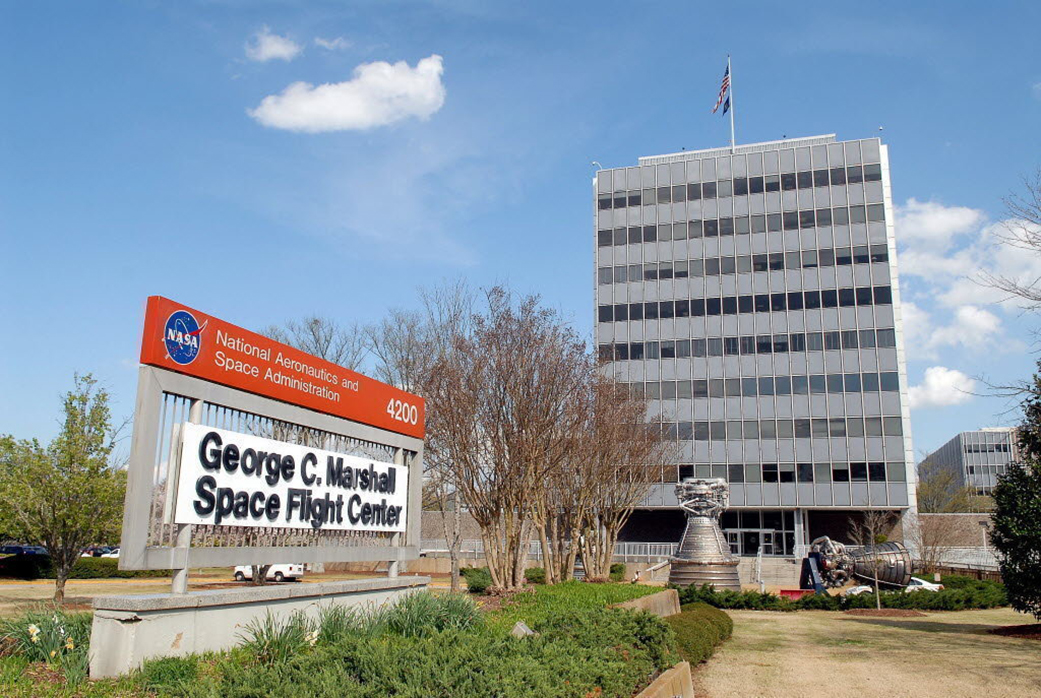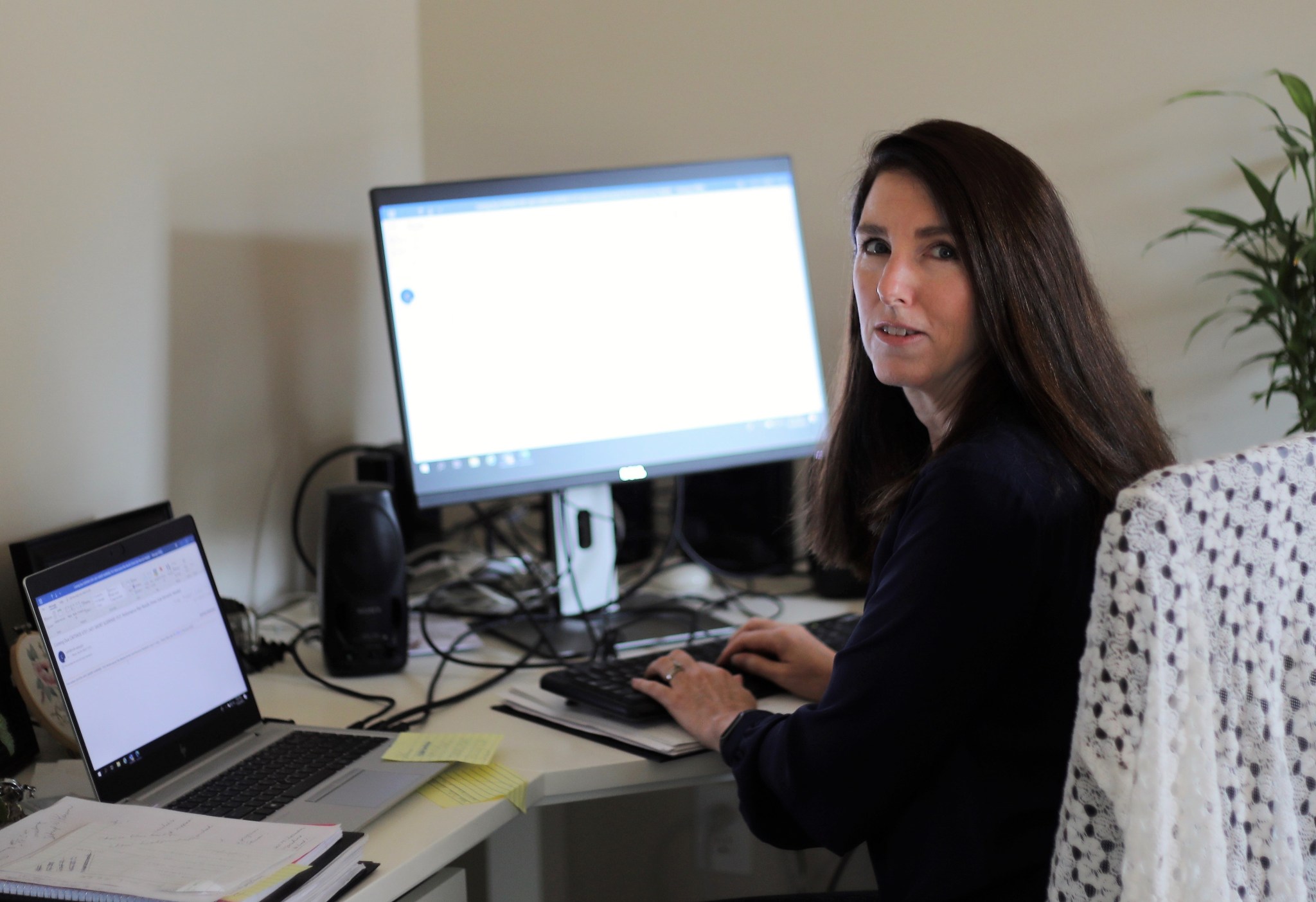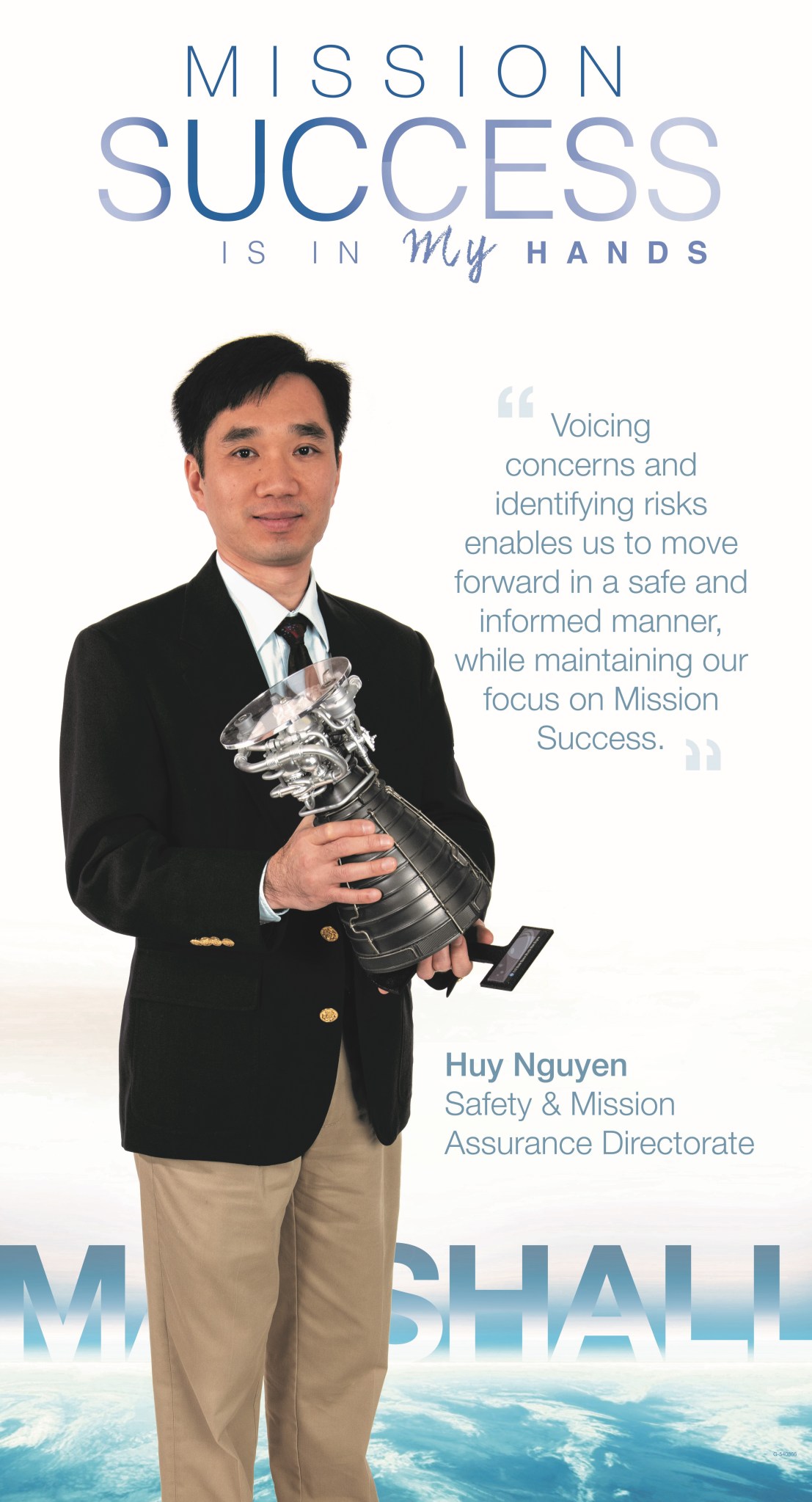In This Week’s Star
- Marshall Master Plan Supports NASA Workforce, Future Missions
- Marshall Leaders to Host Live Virtual Town Hall Oct. 29
- NASA’s OSIRIS-REx Collects Significant Amount of Asteroid, Goes for Early Stow
- Take 5 with Rae Ann Meyer
- Mission Success is in My Hands: Huy Nguyen
- Tom Milner Recognized as HEO HErO
- Marshall to Host 30th Small Business Alliance Meeting Oct. 29
- The Recipe for Powerful Quasar Jets
- Human Exploration Rover Challenge Highlighted on ‘This Week @NASA’
- This Week in NASA History: SA-1 Launches – Oct. 27, 1961
Marshall Master Plan Supports NASA Workforce, Future Missions
by Lance D. Davis
The Marshall Space Flight Center Master Plan outlines phased construction, revitalization, deactivation, and demolition projects to achieve modern, efficient, and affordable operations to support the NASA mission. Marshall is currently working on its new master plan, to include scenarios that project both technical facility needs and administrative and multipurpose space options.
Building 4200 was originally targeted for a 2030 deactivation and demolition to reduce costs and build higher efficiency buildings for better stewardship of taxpayer dollars. However, after a panel fell from the building May 6, further investigations revealed significant exterior structural issues. Based on these structural issues, and other ongoing building code updates needed, Marshall leadership moved the deactivation timeline up to fall 2021. Under the master plan, the center intends to continue vacating and deactivating more of its buildings, while also investing in new, efficient facilities that will equip Marshall for the future.
“It’s not our buildings that make NASA great – it’s the awesome, talented people who serve and support our mission every day,” Marshall Director Jody Singer said. “As we plan for the future, our master plan will provide the best way forward with the needs of our workforce and future missions in mind.”
Netting will be installed on the exterior of Building 4200 between November and December 2020 to protect personnel from potential falling panels. Until further notice, entering and exiting Building 4200 are only allowed through the southwest loading dock entrance to ensure everyone’s safety.
“Protecting the health, safety, and well-being of Marshall team members is our highest priority,” Singer said.
During Stage 3 of the NASA Framework for Return to On-site Work for COVID-19, Marshall team members should request approval from their supervisors before entering Building 4200. Visits should be short, limited to one hour, and can include activities such as printing and picking up needed items or equipment. Occupants at Building 4200 will remain in a mandatory telework status as Marshall moves from Stage 3 through Stage 0 for returning to on-site work and the building transitions to deactivation. The workforce will not be allowed to conduct routine, on-site office work and should contact supervisors about securing alternative, on-site office space if required.
While Building 4200 occupants are on mandatory telework, Marshall leadership is evaluating the best infrastructure options for the workforce and mission. A phased plan developed by Center Operations will be implemented for team members to move their belongings – along with timelines and logistics for Building 4200’s deactivation, relocation of occupants, and its demolition. This plan is still being developed and will include a combination of moving Building 4200 workers to different buildings, hoteling spaces, and telework. Team members should not begin packing and moving activities until supervisors provide them with guidance and instructions. Occupancy will be limited, and supervisors will work with building managers on packing and moving schedules for all team members. Specific packing dates are still being determined, but packing is projected to start in December. Stay informed with the latest updates and information about Building 4200.
“We ask everyone to be patient and optimistic as we work to finalize plans for Building 4200,” said John Green, a master planner in the Facilities Management Office for Center Operations. “We will keep everyone updated to the maximum extent possible.”
Building 4201 is already deactivated and slotted for demolition this fall. Later this year, Marshall will also remove the above-ground steam pipes and old guard shacks at the East and West Test Area entrances.
Marshall has also made a strategic decision to prioritize the construction of a new science and avionics laboratory and Building 4487’s deactivation based on the critical need to modernize the center’s technical, laboratory infrastructure. The new laboratory will be a Lean Efficient Aligned Positioned lab.
According to Green, Lean is the center’s ability to reduce excess infrastructure, creating an opportunity to focus limited operational and maintenance funds on critical assets; Efficient is constructing facilities that take advantage of the latest energy-saving materials, equipment, and practices; Aligned means performing the center’s directive as mandated by NASA’s agency wide, strategic plan objectives; and Positioned refers to the programming and planning to meet these objectives.
“Our goal is to provide state-of-the-art technical facilities to support current and future NASA missions,” Green said. “The LEAP lab will help us get there, improving and supporting infrastructure needs for Marshall’s engineering workforce.”
The master plan forecasts the LEAP lab project to begin in fiscal year 2024. Building 4487 will be deactivated once new laboratory space is completed and available for the engineering workforce.
Developed in 2003 with a 20-year forecast, the center’s master plan serves as a roadmap to the development and sustainment of facilities, structures, utilities, roads, and land to support the NASA mission. Since then, it has been revalidated every five years.
Green and his team of other master planners link the development and stewardship of master planning at Marshall with NASA’s strategic goals, ensuring infrastructure and assets are aligned with center missions in support of the agency’s strategic plan.
Learn more about Facilities Management and Planning & Facilities Utilization.
Davis is a public affairs officer in Marshall’s Office of Strategic Analysis & Communications.
Marshall Leaders to Host Live Virtual Town Hall Oct. 29
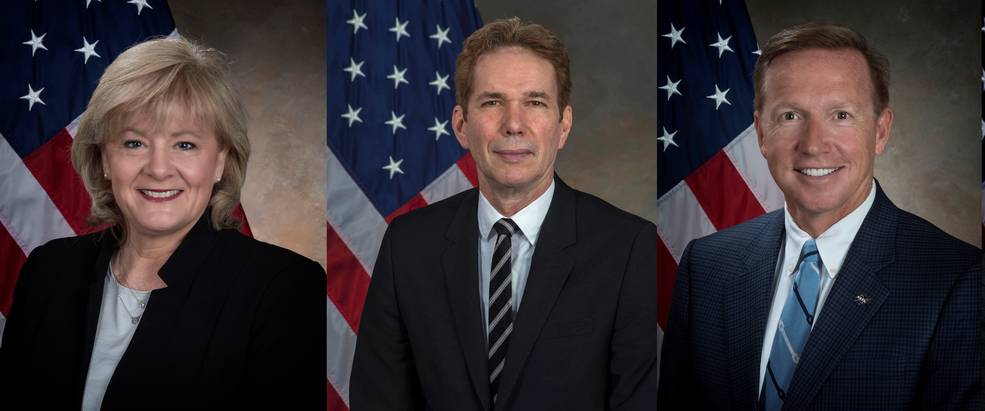
NASA’s Marshall Space Flight Center leaders – from left, Director Jody Singer, Deputy Director Paul McConnaughey, and Associate Director Steve Miley – will address team members in a live virtual town hall Oct. 29 at 3:15 p.m. They will provide updates on mission milestones, the center’s COVID-19 response, NASA’s Return to On-Site Work Framework, and Building 4200. A prime focus will be answering questions from the workforce. Questions can be submitted or upvoted on Inside Marshall until the event begins. Team members should join the meeting using Chrome or Safari. Visit here and follow the instructions to log in. (NASA)
NASA’s OSIRIS-REx Collects Significant Amount of Asteroid, Goes for Early Stow
On Oct. 20, NASA’s Origins, Spectral Interpretation, Resource Identification, Security, Regolith Explorer spacecraft unfurled its robotic arm, and in a first for the agency, collected rocks and dust from the surface of an asteroid. The mission began performing an early stow Oct. 27 – five days sooner than planned – to protect and return to Earth as much of the sample as possible.
The ancient asteroid, known as Bennu, offers scientists a window into the early solar system as it was first taking shape billions of years ago and flinging ingredients that could have helped seed life on Earth.
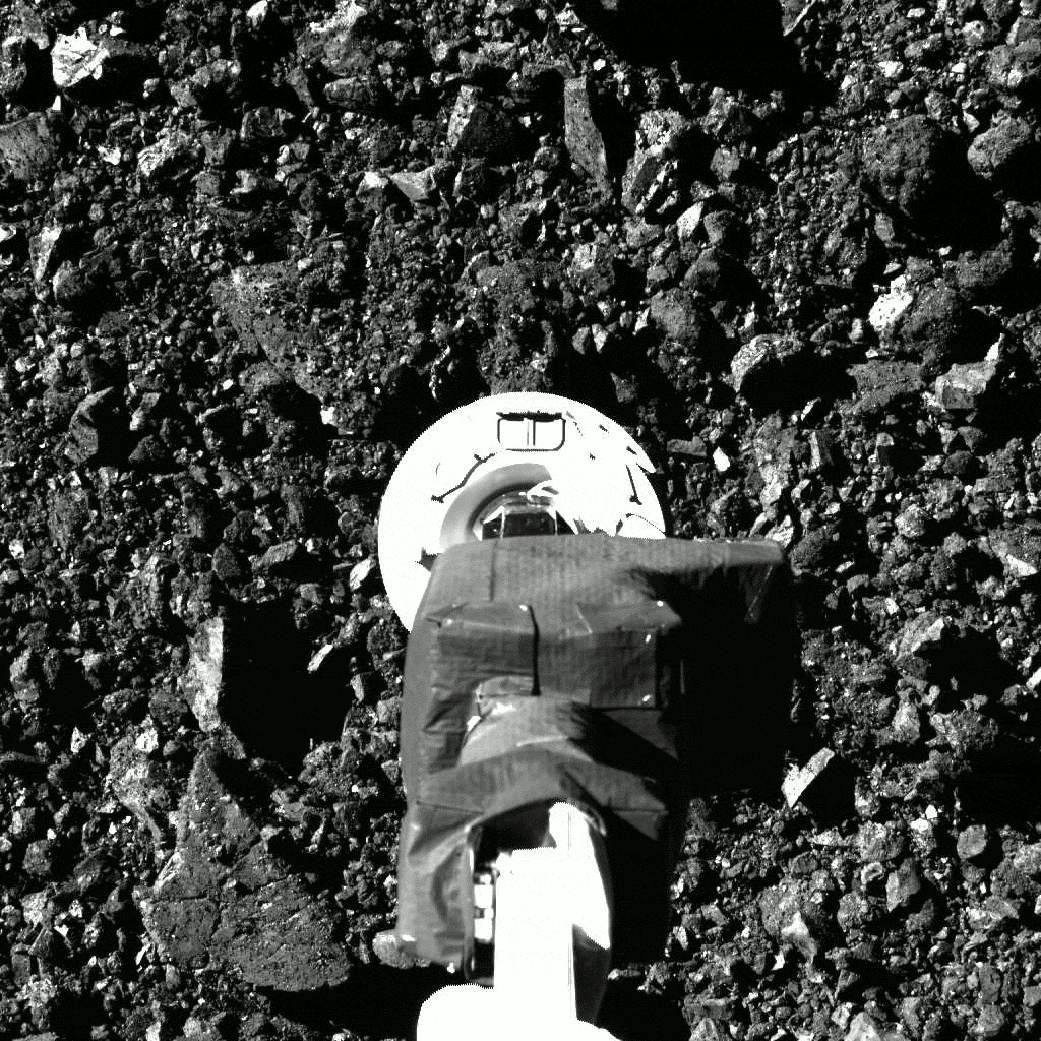
“This first touch-and-go attempt has been executed flawlessly and stands as a testament to the hard work and dedication of the entire OSIRIS-REx team,” said Solveig Irvine, OSIRIS-REx mission manager at NASA’s Planetary Missions Program Office at the agency’s Marshall Space Flight Center. “We have been preparing for this moment for a very long time and to see the Touch and Go Sample Acquisition Mechanism impact Bennu so perfectly – it was an incredible experience.”
On Oct. 22, the OSIRIS-REx mission team received images that showed that the Touch and Go Sample Acquisition Mechanism was overflowing with material collected from Bennu’s surface – well over the 2-ounce mission requirement – and that some of these particles appeared to be slowly escaping from the collection head.
A mylar flap on the TAGSAM allows material to easily enter the collector head and should seal shut once the particles pass through. However, larger rocks that didn’t fully pass through the flap into the TAGSAM appear to have wedged this flap partially open, allowing small bits of the sample to leak out.
Due to the overwhelming success of the first sample collection attempt, NASA’s Science Mission Directorate has given the mission team the go-ahead to expedite sample stowage, originally scheduled for Nov. 2, in the spacecraft’s Sample Return Capsule to minimize further sample loss.
“The abundance of material we collected from Bennu made it possible to expedite our decision to stow,” said Dante Lauretta, OSIRIS-REx principal investigator at the University of Arizona in Tucson. “The team is now working around the clock to accelerate the stowage timeline, so that we can protect as much of this material as possible for return to Earth.”
The mission team anticipates the entire stowage process will take multiple days, at the end of which the sample will be safely sealed in the Sample Return Capsule for the spacecraft’s long journey back to Earth.
NASA’s Goddard Space Flight Center provides overall mission operations management, systems engineering, and safety and mission assurance for OSIRIS-REx. The University of Arizona in Tucson leads the mission’s science observation planning and data processing. Lockheed Martin Space in Denver built the spacecraft and is providing flight operations. Goddard and KinetX Aerospace in Tempe, Arizona, are responsible for navigating the spacecraft. OSIRIS-REx is the third mission in NASA’s New Frontiers Program, which is managed by Marshall for the agency’s Science Mission Directorate.
Take 5 with Rae Ann Meyer
Rae Ann Meyer is the acting manager of the Science and Technology Office at NASA’s Marshall Space Flight Center while David Burns is detailed to NASA’s Science Mission Directorate in Washington. Meyer has been deputy manager of the office since May 2019, helping to plan, develop, and execute a broad range of science and technology investigations, programs, projects, and activities in support of NASA’s space exploration and discovery goals. The office also leads the pursuit of new opportunities and partnerships with other government agencies and private industry.
A native of Chattanooga, Tennessee, Meyer earned a bachelor’s degree in electrical engineering from the University of Tennessee in Knoxville in 1989. She joined NASA as an electrical engineer the same year.
Meyer recently chatted remotely with Marshall media specialist Rick Smith, discussing the Science and Technology Office’s role in executing Marshall’s work and NASA’s mission – and her tips for staying focused in uncertain times and balancing work and play to keep things in perspective.
Question: What is the team environment like in the Science and Technology Office, and how do you encourage collaboration and integration?
Meyer: We have a wide variety of team sizes and cultures owing to the size and scope of our office – from Earth, astrophysics, heliophysics, and planetary sciences to our wide range of technology development efforts, with busy program organizations such as the Planetary Missions Program Office, Centennial Challenges, and the Technology Demonstration Missions Program, and business organizations primarily dedicated to sharing knowledge and expertise, including the Partnerships and Formulation Office, and the Technology Transfer Office.
Collaboration within these teams happens naturally, but at an organizational level, it’s the communication and collaboration fostered by our project managers, supervisors, and resource and integration teams that help to integrate all our activities. Our managers do a wonderful job giving each working team and division the space to be creative, to focus, and to share input and insight across the organization.
Question: What partnerships are your team pursuing to help put the first woman and next man on the Moon by 2024?
Meyer: A portion of the STO team is focused on science that will inform, enable, and benefit from our upcoming crewed Moon missions, or on technology development that will enable a long-term, sustained presence on the lunar surface and robust, rewarding exploration missions beyond. Renee Weber, Marshall’s chief scientist, chairs the Science Mission Directorate’s Science and Technology Definition Team, which is identifying specific science missions to be performed by our new lunar explorers. We’re also managing the Neutron Measurements at Lunar Surface payload – one of 11 science payloads set to fly on Astrobotic’s lander in 2021 – which will assess neutron radiation on the surface and observe and detect the presence of water or other rare elements.
The office also is responsible for developing technologies to enable future missions. NASA’s exciting new Human Landing System Program, a key element of the Artemis program, evolved out of a past STO project. And our Partnerships and Formulation Office continues to seek partnerships with industry and academia, offering Marshall’s legacy of expertise to commercial firms developing lunar projects, technologies, and small payloads. We also continue to provide support to the smaller companies leading the robotic precursor missions in the Commercial Lunar Payload Services program.
Question: How does your organization define and achieve mission success?
Meyer: Our organization, which probably has the most diverse portfolio among all the project and program offices at Marshall, relies on the expertise of our team members, a driving desire to learn and achieve, and the quality of our partnerships. Though we’re technically diverse, we share a dedication to the advancement of knowledge, the efficient and impactful application of that knowledge; and the safe execution of robust projects and research to achieve our goals, whether they fall under the umbrella of science or technology.
Question: What are the unique challenges facing your team in light of COVID-19 and distance-based safety protocols?
Meyer: I am so proud of how our entire team has adjusted, interweaving the needs of their families and their Marshall roles. We were the first Marshall organization to pull off a virtual site visit for a major proposal evaluation – for the Solar Cruiser proposal – by the Science Mission Directorate, and our flexible, creative program and project office teams have become old hands at conducting and participating in major reviews virtually – even if it means, on very rare occasion, someone has to deliver a presentation with a crying child on their lap! We’ve done more than step up – we’ve adapted and pushed through.
Question: What hobbies and activities keep you grounded and relieve stress, especially while teleworking?
Meyer: Working from home is different for each of us, as are our individual challenges. Honestly, it was a blessing having both my kids home this summer with my husband and me. I cooked a lot, often copying items from their favorite restaurants. Then, like many parents, we became empty nesters in August when the kids went to college. That has been another major adjustment! To relieve stress and meet the day, I’ve started taking morning walks. I did the math recently, and I believe I’ve walked more than 500 miles since the pandemic began – without leaving my neighborhood!
Previous Take 5s
Loucious Hires, director of Marshall’s Office of Diversity and Equal Opportunity.
Deborah Crane, Commercial Crew Program launch vehicle chief engineer
Angie Jackman, project manager for the Mars Ascent Vehicle
Rhega Gordon, Marshall’s chief financial officer
Robert Champion, director of Michoud Assembly Facility
Bill Marks, deputy director of Marshall’s Office of Center Operations
Katherine Van Hooser, Marshall’s chief engineer
Bobby Watkins, manager of the Human Exploration Development & Operations Office at Marshall
Neil Rodgers, director of the Office of the Chief Information Officer at Marshall
Lisa Watson-Morgan, manager of NASA’s Human Landing System Program
Mary Beth Koelbl, deputy director of Marshall’s Engineering Directorate
Mission Success is in My Hands: Huy Nguyen
Editor’s note: This is the eighth and final article in a series spotlighting how team members at NASA’s Marshall Space Flight Center make meaningful connections between their jobs and the safety and success of NASA and Marshall missions. The Mission Success Is in Our Hands initiative is a centerwide campaign led by Marshall’s Safety and Mission Assurance Directorate and partner Jacobs Engineering of Huntsville that promotes and strengthens the center’s focus on mission, hardware, and crew safety.
By Adam Farragut
When it comes to mission success and safety, Huy Nguyen has done it all.
As a former propulsion engineer, he spent 12 years focused solely on his program’s success. Now, after spending eight years with the Safety and Mission Assurance Directorate at NASA’s Marshall Space Flight Center, he works daily to help ensure NASA’s missions, operations, and culture are as safe as possible.
“The ultimate goal is to eliminate all known risks in a system through design, but that is not always possible. The next best thing is to mitigate the residual risks,” Nguyen said. “My team is part of the process that identifies hazards associated with NASA’s Space Launch System and makes sure we have controls in place to make SLS as safe as we can make it.”
As Safety and Mission Assurance Assessment Team lead, Nguyen helps review the directorate’s products to ensure appropriate risks, controls, verifications, and other safety considerations have been identified, and that the final product meets Space Launch System requirements.
Nguyen is also Marshall’s Range Safety and Aviation Operations manager, in which he is responsible for managing operations, procurements, and dispositions of the small Unmanned Aircraft System at Marshall and NASA’s Michoud Assembly Facility. He is also a member of Marshall’s Independent Review Team.
For someone whose day-to-day work has such a large focus on safety, it’s somewhat surprising to learn that his original path was all about propulsion.
“I’ve wanted to work for NASA since I was a 12 year old in Vietnam. I always wanted to work in propulsion.” Nguyen said. “But after 12 years in the department, I wanted to expose myself to different areas and see what else was out there. So, I took a detail with SMA, and after doing the work, I realized I could use my engineering expertise in a different way and that this was the place for me.”
However, changing roles required him to completely rethink how he tackled tough problems.
“Before I moved to SMA, I didn’t think much about how things could fail, I was always focused on making sure things worked,” Nguyen said. “I had to retrain myself to work more in a fail state than a success state.”
Although the move made him change his thought process, Nguyen showed glimpses early in his career that safety and mission assurance would be a good fit.
During space shuttle Atlantis’ STS-104 mission in 2001, there was an anomaly where a set of data from one of the systems was different than expected. Although the anomaly had no adverse effects on the crew, the vehicle, or the mission, the team he was a part of realized the outcome could have been much worse and was determined to find the root cause. Using three computer models, including one that was built by Nguyen, the team was able to reconstruct the flight data and resolve the issue for future space shuttle missions.
“By finding the root cause of the anomaly, we had a better understanding of the system and we were able to make it even safer,” Nguyen said.
Now, 20 years later, he realizes more than ever how much impact team members can have on mission and operational safety and success simply by staying vigilant, recognizing risks, and not being afraid to speak out when necessary.
“It’s important that everyone has the courage to voice any concerns they have,” Nguyen said. “Every team member has a unique perspective and sometimes it’s those different viewpoints that can help us identify, understand, and overcome risks in a safe and informed manner.”
Previous Mission Success is in My Hands profiles
David Burns, manager of Marshall’s Science and Technology Office
Johnny Stephenson, director of Marshall’s Office of Strategic Analysis & Communications
Jacob Johnson, a Marshall engineering technician
Rebecca Crownover, Marshall’s Component Development Area team lead
Chip Walraven, senior systems engineer for spacecraft and vehicle support in Marshall’s Engineering Directorate
Gwendolyn Artis, launch vehicle stage adapter technical assistant for NASA’s Space Launch System Program at Marshall.
Angelia Walker, deputy director of the Spacecraft and Vehicle Systems Department at Marshall
Farragut, a Manufacturing Technical Solutions employee, supports Marshall’s Office of Strategic Analysis & Communications.
Tom Milner Recognized as HEO HErO
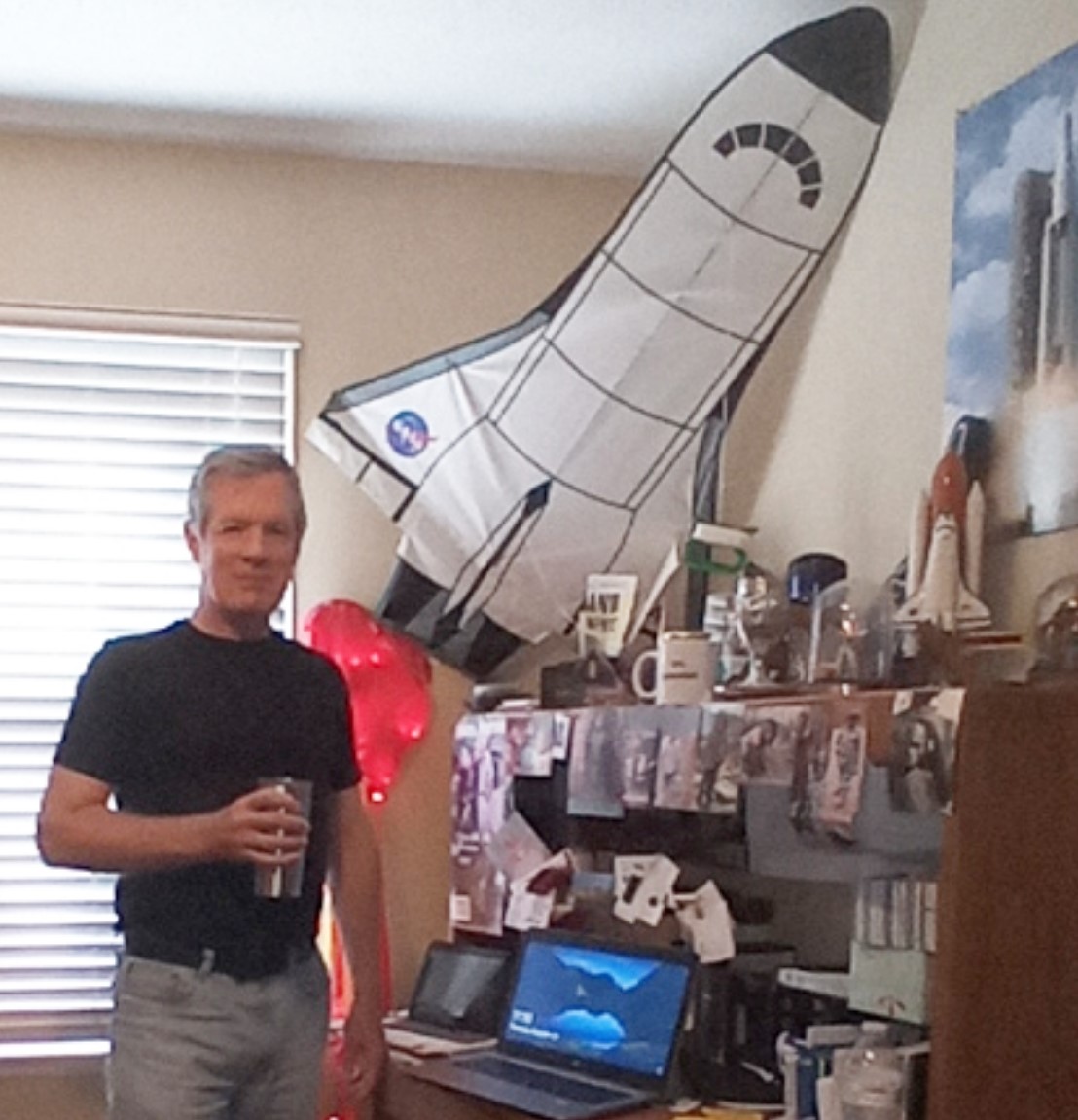
Tom Milner is the latest team member from NASA’s Marshall Space Flight Center to be named a HEO HErO. Milner plays a big role for the Artemis program by leading a team of propulsion engineers that provide critical insight for the certification of the thrust vector control actuator controllers and core auxiliary power units. Each week, NASA’s Human Exploration and Operations Mission Directorate recognizes HEO HErOes, team members from across the agency who have made vital contributions in their support of NASA’s mission to land the first woman and next man on the Moon by 2024. (NASA)
Marshall to Host 30th Small Business Alliance Meeting Oct. 29
On Oct. 29, NASA’s Marshall Space Flight Center will host the 30th Marshall Small Business Alliance meeting via Webex and Microsoft Teams, in keeping with COVID-19 safety protocols. Register for the event here. The number of participants is limited.
The morning session will be held from 9 a.m. to noon, followed by networking opportunities with exhibitors during afternoon breakout sessions. NASA and Marshall leaders – including NASA Deputy Administrator James Morhard, Marshall Associate Director Steve Miley, and David Brock, Marshall small business specialist – will provide flight readiness updates on NASA’s flagship rocket, the Space Launch System, and development of the new Human Landing System that will ferry Artemis Generation crews to the surface of the Moon and back to space again.
Additional updates will cover the continuing work of NASA’s Office of Small Business Programs, the NASA Shared Services Center, and NASA’s Stennis Space Center.
For more than a decade, the Marshall Small Business Alliance meeting has aided small businesses in pursuit of NASA procurement and subcontracting opportunities. The meeting is sponsored by Marshall’s Office of Procurement and Small Business Office.
Interested industry partners can learn more about doing business with Marshall here.
The Recipe for Powerful Quasar Jets
Some supermassive black holes launch powerful beams of material, or jets, away from them, while others do not. Astronomers may now have identified why.
Using data from NASA’s Chandra X-ray Observatory, the European Space Agency’s XMM-Newton, Germany’s ROentgen SATellite, the National Space Foundation’s Karl G. Jansky Very Large Array, the Sloan Digital Sky Survey, and other telescopes, researchers have studied more than 700 quasars – rapidly growing supermassive black holes – to isolate the factors that determine why these black holes launch jets.
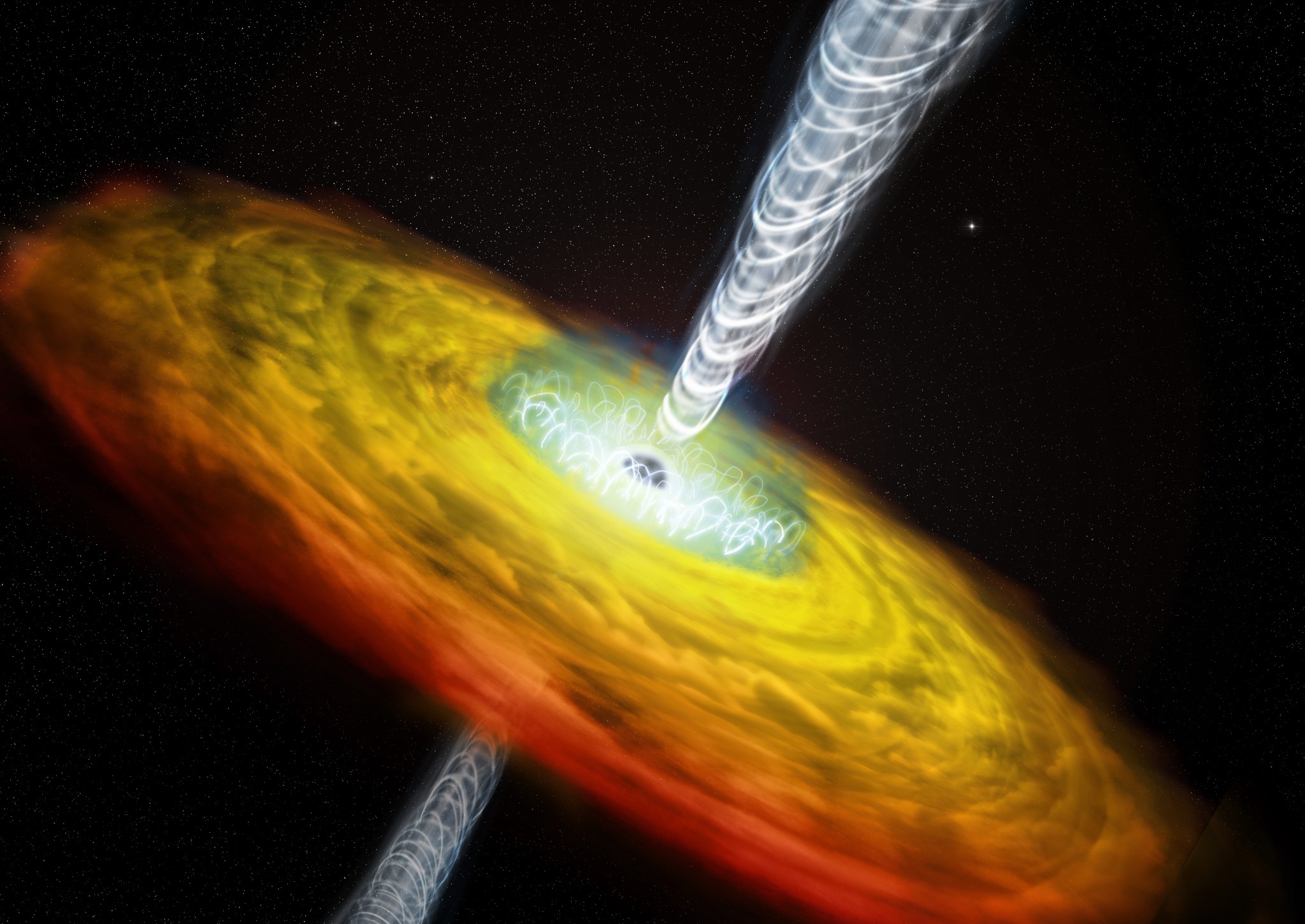
Jets from supermassive black holes can inject huge amounts of energy into their surroundings and strongly influence the evolution of their environments. Previously, scientists realized that a supermassive black hole needs to be spinning rapidly to drive strong jets – but not all rapidly spinning black holes have jets.
“We found there’s another determining factor of whether a supermassive black hole has jets, something called a black hole corona threaded by magnetic fields,” said Shifu Zhu of Penn State University in University Park, Pennsylvania, who led the study. “If you don’t have a black hole corona that’s bright in X-rays, it seems like you don’t have powerful black hole jets.”
In astronomy, the term “corona” is commonly associated with the outer atmosphere of the Sun. Black hole coronas, on the other hand, are regions of diffuse hot gas that lie above and below a much denser disk of material swirling around the gravitational sinkhole. Like the corona around the Sun, black hole coronas are threaded with strong magnetic fields.
“It’s like baking bread where you need a few ingredients to successfully follow the recipe for a loaf,” said co-author Niel Brandt, also of Penn State. “Our results show that one ingredient you can’t do without when ‘making’ powerful quasar jets is a bright corona.”
The team obtained their results by gaining a better understanding of X-ray emission from quasars. Previous studies had shown that quasars without jets show a characteristic link between the strength of their X-ray and ultraviolet emission. This correlation is explained by ultraviolet light from the disk of the black hole striking particles in the corona. The resulting energy boost converts the ultraviolet light to X-rays.
In the new study the team chose to investigate the behavior of quasars that do have jets. They found a correlation between how bright the different quasars are in X-rays and ultraviolet light that is remarkably similar to that found for quasars without jets. They concluded that the X-ray emission in the jet-powering quasars is also produced by a black hole corona.
This conclusion was a surprise. Previously, astronomers thought that X-ray emission from quasars with jets comes from the base of the jets because quasars with jets tend to be brighter in X-rays than those without. The new study confirms this difference in brightness, but concludes that the extra X-ray emission is from brighter black hole coronas than those of quasars with weaker or nonexistent jets.
“The finding that the X-rays in quasars with jets comes from a black hole corona, rather than from the jets, challenges 35 years of thinking about the basic nature of this emission”, said co-author Guang Yang of Texas A&M University in College Station. “It could provide new insight into the physics of these jets.”
These results are similar to those found for stellar-mass black holes, which weigh less than a hundred times the mass of the Sun, compared to supermassive black holes that weigh millions or billions of times the Sun’s mass. This supports the idea that these two different classes of black hole may be similar in terms of their behavior despite their very different sizes.
These results were published in the Monthly Notices of the Royal Astronomical Society on June 20. The paper is also available online. The other co-authors of the paper are Bin Luo of Nanjing University in China, Jianfeng Wu of Xiamen University in China, and Y.Q. Xue of the University of Science and Technology of China in Hefei, China.
NASA’s Marshall Space Flight Center manages the Chandra program. The Smithsonian Astrophysical Observatory’s Chandra X-ray Center controls science and flight operations from Cambridge and Burlington, Massachusetts.
Read more from Chandra here. For more Chandra images, multimedia, and related materials, visit here.
Human Exploration Rover Challenge Highlighted on ‘This Week @NASA’
NASA’s Human Exploration Rover Challenge – hosted by NASA’s Marshall Space Flight Center – is featured in “This Week @NASA,” a weekly video program broadcast on NASA-TV and posted online.
Registration is underway for the 27th challenge, targeted for April 15-17, 2021, at the U.S. Space & Rocket Center. The annual student competition features student-built rovers taking on a course simulating terrain found on the Moon, Mars, and other rocky bodies in the solar system. Find out more at here.
View this and previous episodes at “This Week @NASA” on NASA’s YouTube page.
This Week in NASA History: SA-1 Launches – Oct. 27, 1961
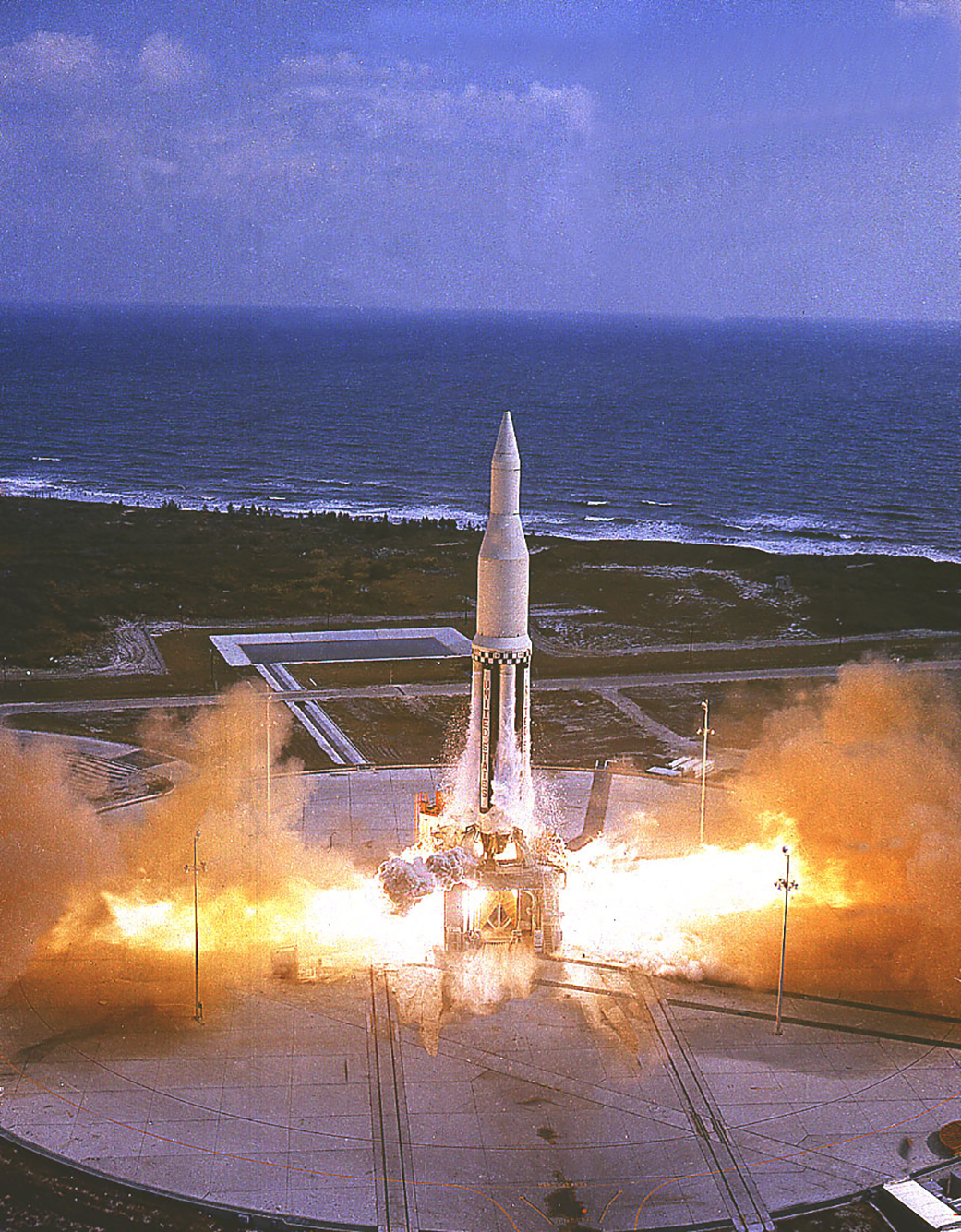
This week in 1961, NASA launched the first test flight of the Saturn I rocket. The uncrewed suborbital flight carried a dummy upper stage filled with water to an altitude of 84.8 miles. The flight accomplished its objective of verifying the aerodynamical and structural design of the Saturn I booster. The rocket stood 162 feet tall, weighed 460 tons, and employed eight H-1 engines. Today, Marshall is playing a vital role in the Artemis program by developing the Space Launch System, the backbone of NASA’s exploration plans and the only rocket capable of sending humans to the Moon and Mars. The NASA History Program is responsible for generating, disseminating, and preserving NASA’s remarkable history and providing a comprehensive understanding of the institutional, cultural, social, political, economic, technological, and scientific aspects of NASA’s activities in aeronautics and space. For more pictures like this one and to connect to NASA’s history, visit the Marshall History Program’s webpage. (NASA)
























